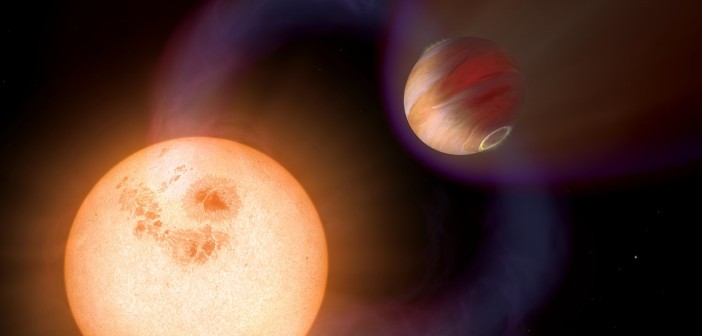We know that the large masses of stars govern the orbits of the planets that circle them — but a large, close-in planet can also influence the rotation of its host star. A recently discovered, unusual hot Jupiter may be causing its star to spin faster than it should.
Exotic Planets
Hot Jupiters are gas giants of roughly Jupiter’s size that orbit close in to their host stars. Though these planets are easy to detect — their large sizes and frequent transits mean surveys have a good chance of catching them — we haven’t found many of them, suggesting that planetary systems containing hot Jupiters are fairly unusual.

The period-folded light curve of HATS-18, revealing the transit of the hot Jupiter HATS-18b. The period is P=0.8378 days. [Penev et al. 2016]
The recent discovery of a transiting hot Jupiter a little over 2000 light-years away therefore presents an exciting opportunity!
A Speeding Giant
The discovery of HATS-18b, a planet of roughly 2 times Jupiter’s mass and 1.3 times its radius, was announced in a study led by Kaloyan Penev (Princeton University). The planet was discovered using the HATSouth transit survey network, which includes instruments in Chile, Namibia, and Australia, and follow-up photometry and spectroscopy was conducted at a variety of ground-based observatories.
HATS-18b’s properties are particularly unusual: this hot Jupiter is zipping around its host star — which is very similar to the Sun — at the incredible pace of one orbit every 0.84 days. HATS-18b’s orbit is more than 20 times closer to its host star than Mercury’s is to the Sun, bringing it so close it nearly grazes the star’s surface!

Size of the planetary orbit relative to the stellar radius as a function of the stellar rotation period, for transiting planets with orbital periods shorter than 2 days and masses greater than 0.1 Jupiter masses. HATS-18b is denoted by the red star. [Penev et al. 2016]
Tidal Interactions
What happens when a massive planet orbits this close to its star? Tidal interactions between the star and the planet cause tidal dissipation in the star, resulting in decay of the planet’s orbit. But there may be an additional effect of this interaction in the case of HATS-18b, the authors claim: the planet may be transferring some of its angular momentum to the star.
As stars age, they should gradually spin slower as they lose angular momentum via stellar winds. But Penev and collaborators note that this exoplanet’s host star, HATS-18, spins roughly three times as fast as its inferred age suggests it should. The authors conclude that the angular momentum lost by the planet as its orbit shrinks is deposited in the star, causing the star to spin up.
HATS-18 is an excellent laboratory for studying how very short-period planets interact with their stars — in fact, Penev and collaborators have already used their observations of the system to constrain models of tidal dissipation from Sun-like stars. Additional observations of HATS-18 and other short-period systems should allow us to further test models of how planetary systems form and evolve.
Citation
K. Penev et al 2016 AJ 152 127. doi:10.3847/0004-6256/152/5/127


3 Comments
Pingback: tail wags dog
Pingback: Astronomia: un gioviano caldo e la sua stella madre "duettano" a distanza ravvicinata - Meteo Web
Pingback: Un esopianeta a braccetto con la sua stella | Accademia delle Stelle